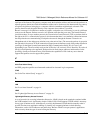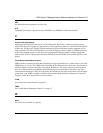
7000 Series L3 Managed Switch Reference Manual for Software v2.0
C-20 Glossary
Protocol Data Unit
PDU is a packet of data passed across a network. The term implies a specific layer of the OSI model and a
specific protocol.
Protocol Independent Multicast – Dense Mode
Like DVMRP, PIM-DM uses a flood and prune protocol for building multicast trees. However, unlike
DVMRP, PIM-DM uses existing unicast protocols for determining the route to the source.
Q
QoS
See “Quality of Service” on page 20.
Quality of Service
QoS is a networking term that specifies a guaranteed level of throughput. Throughput is the amount of data
transferred from one device to another or processed in a specified amount of time - typically, throughputs are
measured in bytes per second (Bps).
R
RADIUS
Short for Remote Authentication Dial-In User Service, RADIUS is an authentication system.
Using RADIUS, you must enter your user name and password before gaining access to a network. This
information is passed to a RADIUS server, which checks that the information is correct, and then authorizes
access. Though not an official standard, the RADIUS specification is maintained by a working group of the
IETF.
Real-Time Operating System
RTOS is a component of the OSAPI module that abstracts operating systems with which other systems can
interface.
Resource Reservation Setup Protocol
RSVP is a new Internet protocol being developed to enable the Internet to support specified
Qualities-of-Service (QoS). Using RSVP, an application will be able to reserve resources along a route from
source to destination. RSVP-enabled routers will then schedule and prioritize packets to meet the
prioritization assigned by QoS. RSVP is a chief component of a new type of Internet being developed,
known broadly as an integrated services Internet. The general idea is to enhance the Internet to support
transmission of real-time data.


















